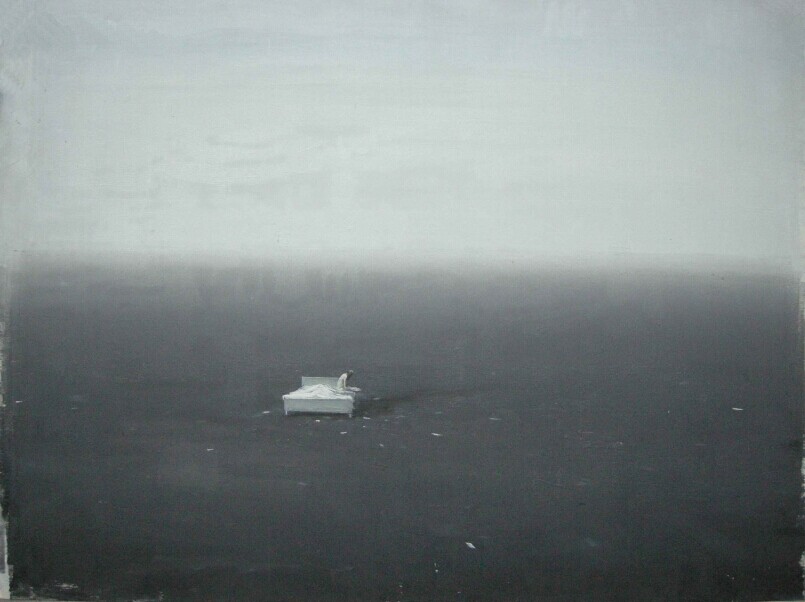
Jia Aili applies an epic vision in paintings that portray man in a chaotic and apocalyptic environment. An environment in which ecological concerns have been overwhelmed by unspecified chaos. Jia Aili’s theatrical approach to painting allows him to make paintings that move off the canvas and onto the walls and floors, extending his field of imagery out from the illusion he has created on the canvas into the real world of objects in space. His paintings frequently depict the image of one human figure. Their theatrical presence is so powerful that often his paintings seem like tableaux in which his solitary character is the single performer in a visual drama set in a bleak landscape.
The plight of the individual in an unforgiving world is a fundamental theme that runs through much contemporary art. The plays of Samuel Beckett above all have consistently expressed this and informed and influenced the subject matter of contemporary artists in the West over the past fifty years. The simple bleakness of Beckett’s sets in which the individual is condemned to a purgatorial existence that has no satisfactory conclusion is the stuff of late modernism. Jia Aili’s early paintings where a lone figure sits on the ground in the centre of an apparently devastated, vast, and totally barren landscape or on a bed abandoned in a post industrial desert devoid of anything else, evokes the iconography and forms of Beckett. But Jia AIli has no such point of reference. His painting has developed in an Oriental context which nevertheless throws up similar concerns.
As a young artist Jia Aili is engaged with this predicament and with all the anxiety it implies when navigating an insular life; confronting inner contradictions and disquiet. But his attention extends from an existential position to consider the implications of environmental catastrophe and political legacy, and the relationship between the two, particularly in the context of China. When Jia Aili’s solitary man tries to rest on a rusting bed or approaches a burnt out car they almost disappear in the expanse of landscape. In his huge paintings these images manifest essential ingredients of late modernism extended to comment on the condition of the modern world as well as the modern man.
The scale of Jia Aili’s paintings are crucial to the experience of his work and the impact of his ideas. There is a physical relationship between the viewer and some of his larger paintings in which, when close to, the viewer cannot see their full extent and so becomes enveloped in the painting. The huge painting he is currently working on in his studio in the northern edge of Beijing is the scale of a backdrop to a stage performance.
As Jia AIli’s work has progressed the lone figure has become more clearly discernable, sometimes drawn into the foreground of the painting rather than adrift far away. He, we assume it is a man, is naked apart from a gas mask of the sort left over from the Second World War. The suggestion is clear, the environment has deteriorated to such an extent that man is stripped of everything but his will to survive. As he wades through a ‘Nameless Lake’ or crouches at the edge of an endless sea in ‘Nameless Day’ (the titles of series of paintings produced in 2006/7), his survival has become dependent upon filtering air into his lungs.
Like many artists trained in China, Jia AIli has a virtuosity with paint that enables him to express his ideas fluently. His facility not only provides him with the technique to depict images as he chooses but to explore and experiment with the painterly properties of the medium. In his more recent works the illustrative dimension of his painting has been augmented with an energetic gestural application of paint that surrounds his central figure, still in the post apocalyptic landscape of despair, in a jungle of brush strokes, flailing strips of matter, a sea of tendrils, a forest of branches, strips of light industrial waste, whatever, they express a psychic condition more than an illusion of reality.
Jia Aili’s concern with the medium of painting per se makes reference to the history of art. His site specific installation at Iniva (shown along side recent paintings that demonstrate the range of his work) is his interpretation of Caraviaggio’s ‘The Incredulity of Saint Thomas’. Inspired by Caravaggio’s masterpiece, Jia Aili applies a study of the shapes and mechanism of interactions in the original work to the windows of the gallery at Invia that face out onto the street to make a composition of shapes - a spotted surface of obliterated faces full of ‘wounds’ and the medication for them.
